
Every time I would go to someone's house in Tokyo, they would likely offer me sencha before I even settled onto my zabuton or chair. Sencha is made by steaming green tea leaves, shaped into thin rolls, dried and then pan-fried or fired to lock-in the flavor. Pretty common in the U.S. as well, most people encounter sencha in Japanese restaurants (it is light green in tint) or at their local Trader Joe's in tea bags (which might even be bancha, see below). As a side note, I will mention the different types of teas made from green tea leaves in Japan (although this post is about sencha).
Types of Green Tea
Gyokuro Made from leaves that are grown in the shade (highest quality stuff), steamed and dried. Gyokuro tastes smooth and mellow.
Sencha Made from leaves that not hidden from the sun (ranges in quality), steamed and dried. Sencha tastes grassy and bright.
Macha Made from grinding steamed, dried leaves into a fine powder. Macha tastes bitter but nutty and almost kind of sweet.
Houjicha Made from leaves roasted in a porcelain container. Houjicha tastes earthy and clear and has a red-tint to it.
Bancha The name translates as "Common tea" and is made from leftover green tea leaves (from higher quality varieties), stems and twigs. Bancha tea leaves are harvested at the end of the season. Bancha is even more earthy tasting than houjicha - almost hearty but not as clear as the other types.
Before I left Japan, the owner of
Washio, a tiny bar/izakaya that specializes in seafood and seats six people, gave me two packs of "shin-cha" sencha. Shin-cha literally translates as "new tea," but explained more accurately by describing it as the first pick of the harvest. Shin-cha means that the leaves pack the punch as far as nutrients, brightness and depth of flavor.
And here are the two packages of shin-cha sencha that he sent my husband and I to America with.
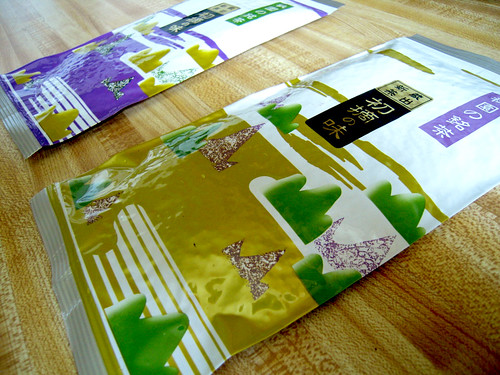
These leaves were grown and harvested in the most coveted region for green tea, the southern Japanese island of
Shikoku. This tea leaf company is called
Hirakien.
How to prepare and drink sencha
Open the package and store in an air-tight container. Store in a cool, dark place.
Boil water until your tea kettle is rocking back and forth or whistling furiously (approximately 100°C). Turn off the heat.
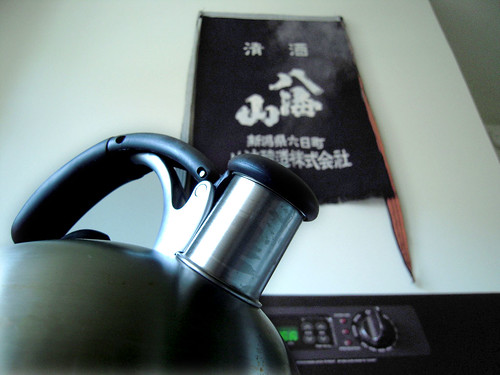
Have your teapot (kyusu) ready on the side and scoop a heaping teaspoon of sencha and put into your teapot.


Wait until your water cools down a little bit to about 80°C.
Pour the water into your teapot. Wait for 60-90 seconds.
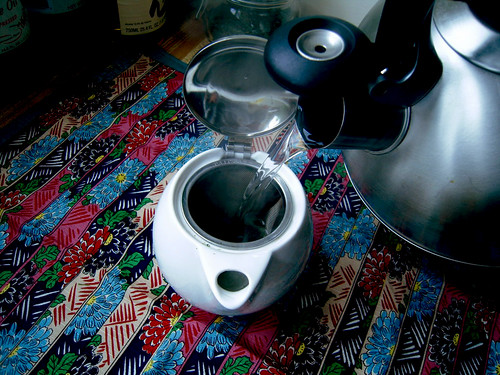
Pour all the content of the teapot into tea cups. You want to avoid water soaking the leaves for extended amounts of time.
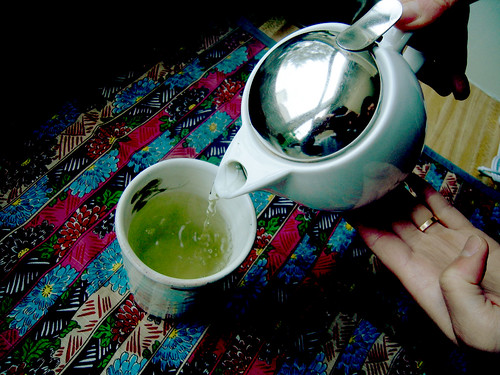
You can pour hot water again into the teapot another 2-3 times and still extract flavorful tea.
When drinking from a teacup, there is a particular way to hold the cup to avoid burning yourself. Grab the cup with one hand with your thumb and fore or middle finger at the top third of the cup - the lower you try to grab it, the hotter it is. Support the underside of the cup with your other hand.
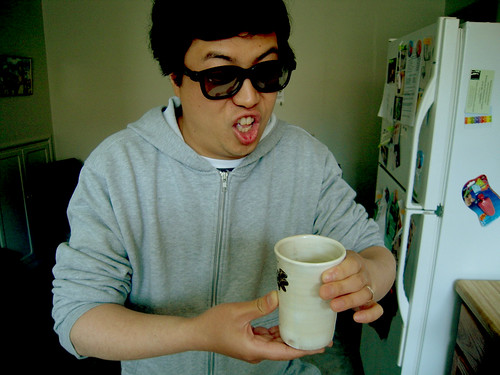 Achiiii! (hotttt!)
Achiiii! (hotttt!)
My Japanese husband tells me that if your fingers do get uncomfortably hot, you can diffuse the heat in your fingers by pinching your earlobes.
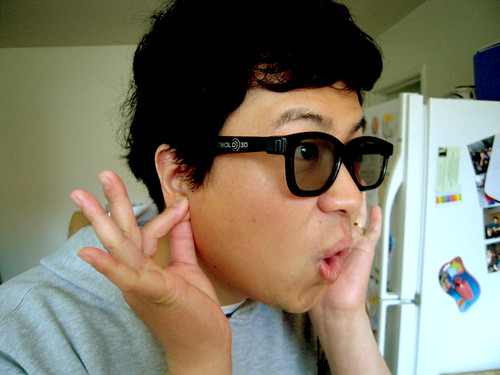
 Every time I would go to someone's house in Tokyo, they would likely offer me sencha before I even settled onto my zabuton or chair. Sencha is made by steaming green tea leaves, shaped into thin rolls, dried and then pan-fried or fired to lock-in the flavor. Pretty common in the U.S. as well, most people encounter sencha in Japanese restaurants (it is light green in tint) or at their local Trader Joe's in tea bags (which might even be bancha, see below). As a side note, I will mention the different types of teas made from green tea leaves in Japan (although this post is about sencha).
Types of Green Tea
Gyokuro Made from leaves that are grown in the shade (highest quality stuff), steamed and dried. Gyokuro tastes smooth and mellow.
Sencha Made from leaves that not hidden from the sun (ranges in quality), steamed and dried. Sencha tastes grassy and bright.
Macha Made from grinding steamed, dried leaves into a fine powder. Macha tastes bitter but nutty and almost kind of sweet.
Houjicha Made from leaves roasted in a porcelain container. Houjicha tastes earthy and clear and has a red-tint to it.
Bancha The name translates as "Common tea" and is made from leftover green tea leaves (from higher quality varieties), stems and twigs. Bancha tea leaves are harvested at the end of the season. Bancha is even more earthy tasting than houjicha - almost hearty but not as clear as the other types.
Before I left Japan, the owner of Washio, a tiny bar/izakaya that specializes in seafood and seats six people, gave me two packs of "shin-cha" sencha. Shin-cha literally translates as "new tea," but explained more accurately by describing it as the first pick of the harvest. Shin-cha means that the leaves pack the punch as far as nutrients, brightness and depth of flavor.
And here are the two packages of shin-cha sencha that he sent my husband and I to America with.
Every time I would go to someone's house in Tokyo, they would likely offer me sencha before I even settled onto my zabuton or chair. Sencha is made by steaming green tea leaves, shaped into thin rolls, dried and then pan-fried or fired to lock-in the flavor. Pretty common in the U.S. as well, most people encounter sencha in Japanese restaurants (it is light green in tint) or at their local Trader Joe's in tea bags (which might even be bancha, see below). As a side note, I will mention the different types of teas made from green tea leaves in Japan (although this post is about sencha).
Types of Green Tea
Gyokuro Made from leaves that are grown in the shade (highest quality stuff), steamed and dried. Gyokuro tastes smooth and mellow.
Sencha Made from leaves that not hidden from the sun (ranges in quality), steamed and dried. Sencha tastes grassy and bright.
Macha Made from grinding steamed, dried leaves into a fine powder. Macha tastes bitter but nutty and almost kind of sweet.
Houjicha Made from leaves roasted in a porcelain container. Houjicha tastes earthy and clear and has a red-tint to it.
Bancha The name translates as "Common tea" and is made from leftover green tea leaves (from higher quality varieties), stems and twigs. Bancha tea leaves are harvested at the end of the season. Bancha is even more earthy tasting than houjicha - almost hearty but not as clear as the other types.
Before I left Japan, the owner of Washio, a tiny bar/izakaya that specializes in seafood and seats six people, gave me two packs of "shin-cha" sencha. Shin-cha literally translates as "new tea," but explained more accurately by describing it as the first pick of the harvest. Shin-cha means that the leaves pack the punch as far as nutrients, brightness and depth of flavor.
And here are the two packages of shin-cha sencha that he sent my husband and I to America with.
 These leaves were grown and harvested in the most coveted region for green tea, the southern Japanese island of Shikoku. This tea leaf company is called Hirakien.
How to prepare and drink sencha
Open the package and store in an air-tight container. Store in a cool, dark place.
Boil water until your tea kettle is rocking back and forth or whistling furiously (approximately 100°C). Turn off the heat.
These leaves were grown and harvested in the most coveted region for green tea, the southern Japanese island of Shikoku. This tea leaf company is called Hirakien.
How to prepare and drink sencha
Open the package and store in an air-tight container. Store in a cool, dark place.
Boil water until your tea kettle is rocking back and forth or whistling furiously (approximately 100°C). Turn off the heat.
 Have your teapot (kyusu) ready on the side and scoop a heaping teaspoon of sencha and put into your teapot.
Have your teapot (kyusu) ready on the side and scoop a heaping teaspoon of sencha and put into your teapot.

 Wait until your water cools down a little bit to about 80°C.
Pour the water into your teapot. Wait for 60-90 seconds.
Wait until your water cools down a little bit to about 80°C.
Pour the water into your teapot. Wait for 60-90 seconds.
 Pour all the content of the teapot into tea cups. You want to avoid water soaking the leaves for extended amounts of time.
Pour all the content of the teapot into tea cups. You want to avoid water soaking the leaves for extended amounts of time.
 You can pour hot water again into the teapot another 2-3 times and still extract flavorful tea.
When drinking from a teacup, there is a particular way to hold the cup to avoid burning yourself. Grab the cup with one hand with your thumb and fore or middle finger at the top third of the cup - the lower you try to grab it, the hotter it is. Support the underside of the cup with your other hand.
You can pour hot water again into the teapot another 2-3 times and still extract flavorful tea.
When drinking from a teacup, there is a particular way to hold the cup to avoid burning yourself. Grab the cup with one hand with your thumb and fore or middle finger at the top third of the cup - the lower you try to grab it, the hotter it is. Support the underside of the cup with your other hand.
 Achiiii! (hotttt!)
My Japanese husband tells me that if your fingers do get uncomfortably hot, you can diffuse the heat in your fingers by pinching your earlobes.
Achiiii! (hotttt!)
My Japanese husband tells me that if your fingers do get uncomfortably hot, you can diffuse the heat in your fingers by pinching your earlobes.


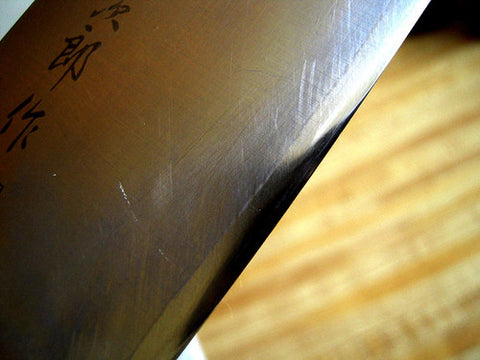


Comments (27)
Hahahaaa, wonderful pictures!
Also, great tips, I think I’m soaking the leaves for too long. 90 seconds max, got it.
I do the earlobe thing! Maybe not while making that face, though… haha
I need to get a good teapot.
Anders, yes – 90 seconds max or else it’ll get all bitter.
Seri – Really? You don’t make that face every time? That’s disappointing.
haha i always pinch my earlobes to diffuse the heat in the fingers. Thanks for sharing that!
Nobuko, thanks for dropping by to read my post. I had never heard of that earlobe thing until I went to Japan!
My grandma used to do the earlobe thing in Japan. She also said to put soy sauce on burns but I think that was a joke.
I love Matcha! I love making it with my spoon and whisk from Tsukjiri in Kyoto.
I always love a good Early Gray with a splash of cream!
Love the photos here!
My favorite tea is genmaicha. I get a couple good pinches of loose leaf – always try to have a few popped rice grains in there. Then brew it in an iron teapot. If I’m feeling fancy, pour into one of the few yunomi I have; otherwise, just a mug. (I use light-colored ones to see the color of the tea.)
nice! I have a feeling that a rolling boil is too hot for sencha, might wanna let the kettle sit for a bit before pouring it over the leaves. Tea love is real. My fave is a 3 way tie between: 1. a hot grassy sencha alone cupped between two hands watching the sunrise. 2. black tea (earl grey, pu-erh or even oolong) w/ coconut sugar & a heavy splash of cream with friends over pastries or 3. a tart rose hip & spicy ginger-citrus herbal tea with spiced rum to cure anything that ales ya!
My current favorite way to drink tea is drinking black tea with milk at afternoon tea. However, I’m hoping that someday someone will do the Japanese version of afternoon tea with Japanese tea and variety of “wagashi” & Japanese finger foods!!